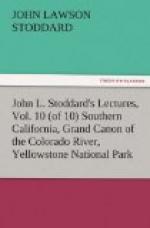Another striking feature of our National Park is its Petrified Forest, where, scattered over a large area, are solitary columns, which once were trunks of trees, but now are solid shafts of agate. The substance of the wood, however, is still apparent, the bark, the worm-holes, and even the rings of growth being distinctly visible; but every fibre has been petrified by the mysterious substitution of a mineral deposit. No doubt these trees were once submerged in a strong mineral solution, tinted with every color of the rainbow. Still, more marvelous to relate, an excavation on the hillside proves that there are eleven layers of such forests, one above another, divided by as many cushions of lava. Think of the ages represented here, during which all these different forests grew, and were successively turned to stone! This, therefore, is another illustration of the conflict between Life and Death. Each was in turn a victor, and rested on his laurels for unnumbered centuries. Life is triumphant now; but who shall say that Death may not again prove conqueror? If not immediately, Death may well be patient. He will rule all this planet in the end.
[Illustration: A NATURAL BRIDGE.]
[Illustration: A PETRIFIED FOREST.]
No one can travel through the Yellowstone Park without imagining how it looks in winter. The snowfall is enormous, some drifts in the ravines being hundreds of feet deep, and, owing to the increased supply of water, the geysers throw higher streams. No traveling is possible then except on snowshoes; and it is with difficulty that some of the Park hotels are reached as late as the middle of May. Of course, in such a frigid atmosphere, the steam arising from the geysers is almost instantly congealed; and eye-witnesses affirm that, in a temperature of forty degrees below zero, the clouds of vapor sent up by Old Faithful rose fully two thousand feet, and were seen ten miles away.
[Illustration: THE PARK IN WINTER.]
It can be well imagined that to do much exploration here, in winter, is not alone immensely difficult, but dangerous. In 1887 an expedition was formed, headed by Lieutenant Frederick Schwatka; but, though he was experienced as an Arctic traveler, in three days he advanced only twenty miles, and finally gave out completely. Most of the exploring party turned back with him; but four kept heroically on, one of whom was the photographer, Mr. F.J. Haynes, of St. Paul. Undismayed by Schwatka’s failure, he and his comrades bravely persisted in their undertaking. For thirty days the mercury never rose higher than ten degrees below zero. Once it marked fifty-two degrees below! Yet these men were obliged to camp out every night, and carry on their shoulders provisions, sleeping-bags, and photographic instruments. But, finally, they triumphed over every obstacle, having in midwinter made a tour of two hundred miles through the Park. Nevertheless, they almost lost




